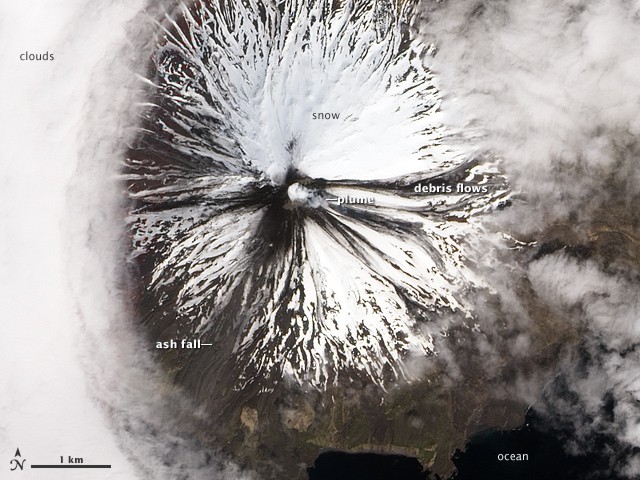Report on Cleveland (United States) — June 2010
Bulletin of the Global Volcanism Network, vol. 35, no. 6 (June 2010)
Managing Editor: Richard Wunderman.
Cleveland (United States) Small ash eruptions during 25 May to early June 2010
Please cite this report as:
Global Volcanism Program, 2010. Report on Cleveland (United States) (Wunderman, R., ed.). Bulletin of the Global Volcanism Network, 35:6. Smithsonian Institution. https://doi.org/10.5479/si.GVP.BGVN201006-311240
Cleveland
United States
52.825°N, 169.944°W; summit elev. 1730 m
All times are local (unless otherwise noted)
The Alaska Volcano Observatory (AVO) noted four explosive events at Cleveland in 2009, the last causing a diffuse ash plume on 12 December (BGVN 34:12). Additional small ash clouds have since been observed during late May and early June.
On 25 May 2010, AVO warned that thermal anomalies observed in satellite data over the past few days suggested another period of unrest. In the past, thermal anomalies at the summit have been followed by moderate ash bursts, sometimes to aircraft flight levels. An ash cloud was visible in a satellite image at 0756 on 30 May. It rose to an altitude of ~ 4.9 km and drifted to the SW. At the time of the satellite image, the cloud was detached, and it was estimated that the emission had occurred several hours earlier. The event was interpreted as a short-lived ash emission without signs of further activity. Satellite images from 31 May also showed minor deposits on the upper flanks, and a 1 June image showed debris flow deposits down the E flank and ashfall deposits on the SW flank. Small plume were seen rising from the crater on 1 and 4 June (figure 8). A weak thermal anomaly detected on 2 June suggested continuing low-level ash emission.
From 5-9 June 2010, satellite images of Cleveland were mostly obscured by clouds, and AVO received no reports of ash emission. On 10 June, a partly cloudy satellite view lacked evidence of ash emissions or thermal anomalies.
Geological Summary. The beautifully symmetrical Mount Cleveland stratovolcano is situated at the western end of the uninhabited Chuginadak Island. It lies SE across Carlisle Pass strait from Carlisle volcano and NE across Chuginadak Pass strait from Herbert volcano. Joined to the rest of Chuginadak Island by a low isthmus, Cleveland is the highest of the Islands of the Four Mountains group and is one of the most active of the Aleutian Islands. The native name, Chuginadak, refers to the Aleut goddess of fire, who was thought to reside on the volcano. Numerous large lava flows descend the steep-sided flanks. It is possible that some 18th-to-19th century eruptions attributed to Carlisle should be ascribed to Cleveland (Miller et al., 1998). In 1944 it produced the only known fatality from an Aleutian eruption. Recent eruptions have been characterized by short-lived explosive ash emissions, at times accompanied by lava fountaining and lava flows down the flanks.
Information Contacts: Alaska Volcano Observatory (AVO), a cooperative program of the U.S. Geological Survey, 4200 University Drive, Anchorage, AK 99508-4667, USA; Geophysical Institute, University of Alaska, PO Box 757320, Fairbanks, AK 99775-7320, USA; and Alaska Division of Geological & Geophysical Surveys, 794 University Ave., Suite 200, Fairbanks, AK 99709, USA (URL: http://www.avo.alaska.edu/); NASA Earth Observatory (URL: http://earthobservatory.nasa.gov/NaturalHazards); NASA/GSFC/METI/ERSDAC/JAROS and U.S./Japan ASTER Science Team (URL: http://asterweb.jpl.nasa.gov/).


